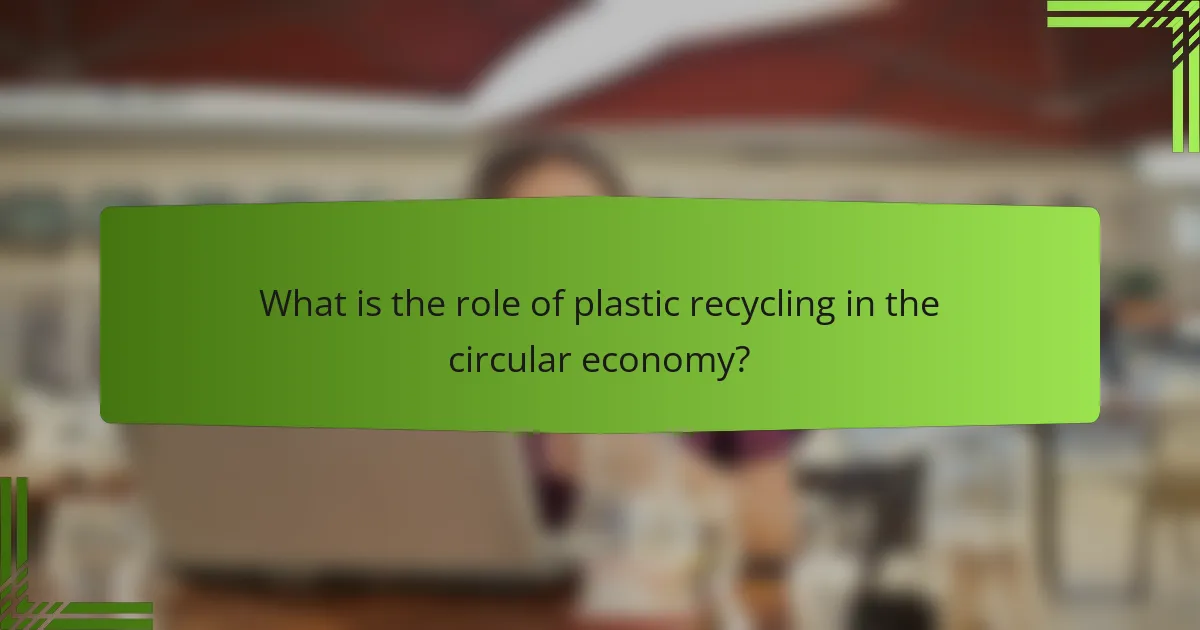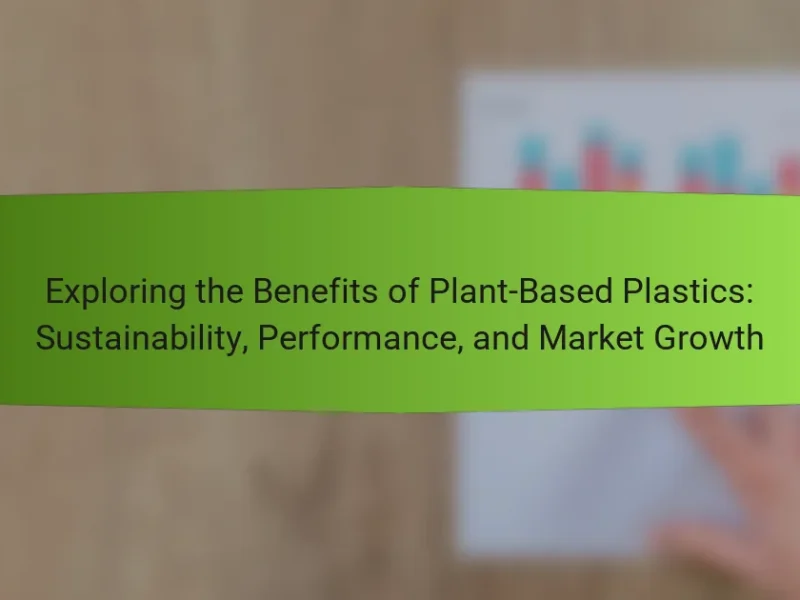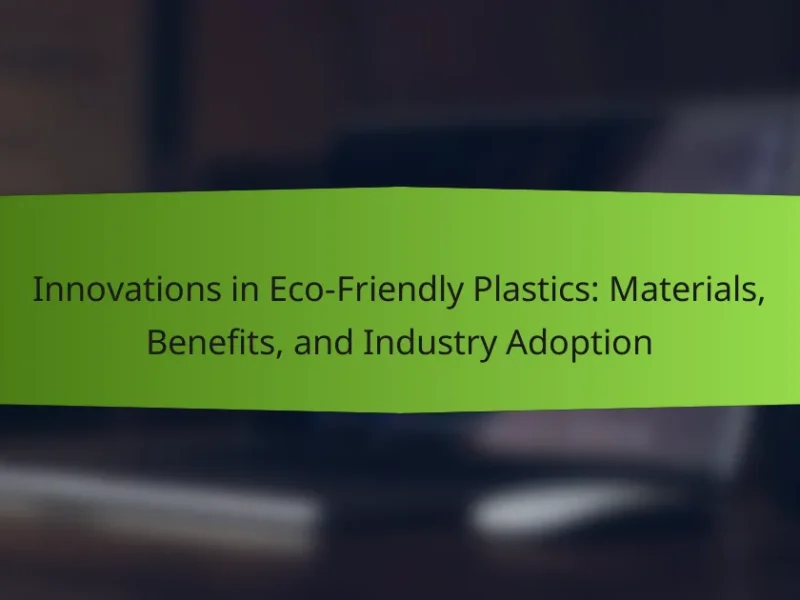Plastic recycling is a key process within the circular economy, transforming used plastics into new products and significantly reducing the need for virgin materials. This reprocessing not only minimizes environmental impact by conserving natural resources and decreasing landfill waste, but it also contributes to economic growth by generating jobs in recycling and manufacturing. The Ellen MacArthur Foundation highlights that effective recycling can lower greenhouse gas emissions, supporting sustainability efforts. This article examines the processes involved in plastic recycling, its benefits for resource efficiency, and the challenges faced in implementing a robust recycling system.

What is the role of plastic recycling in the circular economy?
Plastic recycling plays a crucial role in the circular economy by enabling the reprocessing of used plastics into new products. This process reduces the demand for virgin plastic, thereby lowering environmental impact. Recycling helps conserve natural resources and reduces landfill waste. According to the Ellen MacArthur Foundation, recycling can significantly decrease greenhouse gas emissions. It also supports economic growth by creating jobs in the recycling and manufacturing sectors. The circular economy aims to keep materials in use for as long as possible, and plastic recycling is essential for achieving this goal. By fostering a sustainable lifecycle for plastic products, recycling contributes to resource efficiency and environmental sustainability.
How does plastic recycling contribute to sustainability?
Plastic recycling contributes to sustainability by reducing waste and conserving resources. It prevents plastic waste from ending up in landfills and oceans. Recycling plastic saves energy compared to producing new plastic from raw materials. For instance, recycling can save up to 66% of the energy required for new plastic production. Additionally, it lowers greenhouse gas emissions associated with plastic manufacturing. The recycling process can convert used plastics into new products, promoting a circular economy. This approach helps to decrease the demand for virgin materials. Furthermore, increased recycling rates can lead to economic benefits, including job creation in the recycling industry. Overall, plastic recycling plays a crucial role in enhancing environmental sustainability.
What are the key processes involved in plastic recycling?
The key processes involved in plastic recycling include collection, sorting, cleaning, shredding, and reprocessing. Collection involves gathering used plastic materials from various sources. Sorting separates plastics by type and color, ensuring uniformity for recycling. Cleaning removes contaminants, such as food residues and labels, enhancing the quality of the recycled material. Shredding breaks down plastics into small flakes or pellets for easier handling. Reprocessing involves melting and reforming the shredded plastic into new products. These processes collectively contribute to reducing plastic waste and promoting sustainability in the circular economy.
How does plastic recycling reduce waste and pollution?
Plastic recycling reduces waste and pollution by converting used plastics into new materials. This process decreases the amount of plastic waste sent to landfills. In 2018, approximately 27 million tons of plastic waste were generated in the U.S. alone. Recycling prevents this waste from contaminating natural environments. It also reduces the demand for new plastic production. Manufacturing new plastics often involves fossil fuels, which contribute to greenhouse gas emissions. According to the EPA, recycling plastic can save up to 66% of the energy required to produce new plastic. Additionally, recycling helps to minimize ocean pollution. It prevents plastics from breaking down into microplastics that harm marine life. Overall, effective plastic recycling plays a crucial role in reducing environmental impact.
What are the benefits of plastic recycling in the circular economy?
Plastic recycling in the circular economy reduces waste and conserves resources. It minimizes the need for virgin materials, which decreases environmental impact. Recycling plastic can save up to 66% of energy compared to producing new plastic. It also lowers greenhouse gas emissions, contributing to climate change mitigation. Additionally, recycling creates jobs in the recycling and manufacturing sectors. The circular economy promotes sustainable practices, leading to a more resilient economy. Overall, plastic recycling plays a crucial role in sustainability and resource efficiency.
How does plastic recycling create economic opportunities?
Plastic recycling creates economic opportunities by generating jobs and fostering new business ventures. The recycling industry employs over 1.1 million workers in the United States alone. This sector includes collection, sorting, processing, and selling recycled materials. Additionally, recycling reduces raw material costs for manufacturers. It can lower production costs by up to 30% compared to using virgin materials. Furthermore, recycling contributes to innovation in product development. Companies are increasingly creating products from recycled plastics, leading to a growing market demand. Overall, plastic recycling supports sustainable economic growth while addressing environmental concerns.
What environmental benefits are associated with plastic recycling?
Plastic recycling reduces environmental pollution significantly. It minimizes the amount of plastic waste in landfills and oceans. According to the Environmental Protection Agency, recycling one ton of plastic can save approximately 7.4 cubic yards of landfill space. This process conserves natural resources by reducing the need for new raw materials. For instance, recycling plastic saves up to 88% of energy compared to producing new plastic from petroleum. Furthermore, plastic recycling lowers greenhouse gas emissions. The recycling process emits fewer pollutants than incineration or landfill disposal. Overall, plastic recycling plays a crucial role in promoting sustainability and protecting ecosystems.
What challenges does plastic recycling face in the circular economy?
Plastic recycling faces several challenges in the circular economy. One major challenge is the contamination of plastic waste. Contaminants can hinder the recycling process and reduce the quality of recycled materials. Another challenge is the lack of infrastructure for effective collection and sorting of plastics. Many regions lack the necessary facilities to process plastic waste efficiently. Additionally, the variability in plastic types complicates recycling efforts. Different plastics have different properties, making it difficult to create a uniform recycling stream. Market demand for recycled plastics is also inconsistent. Fluctuations in demand can lead to economic instability for recycling businesses. Lastly, consumer awareness and participation in recycling programs are often low. This results in lower recycling rates and increased landfill waste.
What are the technological barriers to effective plastic recycling?
Technological barriers to effective plastic recycling include material contamination, lack of efficient sorting technologies, and limited recycling processes for certain plastics. Contamination occurs when non-recyclable materials mix with recyclables, reducing quality. Current sorting technologies often fail to distinguish between different types of plastics, leading to inefficient recycling. Additionally, many plastics, like polystyrene and certain multi-layer materials, lack established recycling methods. According to a report by the World Economic Forum, only 9% of plastic waste is recycled globally due to these technological challenges.
How do market dynamics affect plastic recycling efforts?
Market dynamics significantly influence plastic recycling efforts. Fluctuations in demand for recycled materials affect the economic viability of recycling programs. When prices for virgin plastics decrease, recycling becomes less profitable. This leads to reduced investment in recycling infrastructure. Conversely, high demand for recycled plastics can boost recycling rates. Regulatory changes also impact market dynamics. For instance, stricter regulations on plastic waste can encourage recycling initiatives. Additionally, consumer awareness and preferences drive demand for sustainable products. As a result, market dynamics play a crucial role in shaping the effectiveness of plastic recycling efforts.
How can stakeholders improve plastic recycling practices?
Stakeholders can improve plastic recycling practices by enhancing collaboration across the supply chain. This includes manufacturers, retailers, and consumers working together. Implementing standardized labeling on plastic products aids in proper sorting. Education campaigns can raise awareness about the importance of recycling. Investing in advanced recycling technologies increases efficiency. Local governments can provide better access to recycling facilities. Incentives for businesses that prioritize recycled materials can drive change. Studies show that improved recycling rates can significantly reduce landfill waste and environmental impact.
What role do consumers play in enhancing plastic recycling initiatives?
Consumers play a crucial role in enhancing plastic recycling initiatives. Their participation in recycling programs increases the volume of materials collected. Awareness and education about proper recycling practices lead to higher quality recyclables. Consumers can influence businesses by demanding sustainable packaging options. Their choices can drive market demand for recycled materials. Community engagement in local recycling programs further supports these initiatives. Statistics show that increased consumer participation can significantly improve recycling rates. For example, areas with active consumer involvement have reported up to 30% higher recycling rates compared to those with less engagement.
What best practices can businesses adopt for effective plastic recycling?
Businesses can adopt several best practices for effective plastic recycling. First, they should implement a comprehensive waste management system. This system should include clearly labeled recycling bins for different types of plastics. Second, businesses must educate employees about proper recycling practices. Training sessions can improve compliance and reduce contamination in recycling streams. Third, companies should establish partnerships with local recycling facilities. These partnerships can enhance the efficiency of recycling processes. Fourth, businesses can invest in technology for better sorting and processing of plastics. Advanced equipment can increase the quality of recycled materials. Fifth, they should track and report recycling metrics. This data helps identify areas for improvement and demonstrates commitment to sustainability. According to the Environmental Protection Agency, recycling and composting prevented the release of approximately 186 million metric tons of carbon dioxide equivalent into the air in 2018. This statistic underscores the environmental benefits of effective recycling practices.
The main entity of the article is plastic recycling, which is integral to the circular economy. The article outlines the essential processes involved in plastic recycling, including collection, sorting, cleaning, shredding, and reprocessing, while highlighting its benefits such as reducing waste, conserving resources, and lowering greenhouse gas emissions. It also addresses the economic opportunities created through job generation and innovation in product development. Furthermore, the article discusses the challenges faced in recycling, including contamination, technological barriers, and market dynamics, and emphasizes the role of stakeholders and consumers in enhancing recycling practices for improved sustainability.


